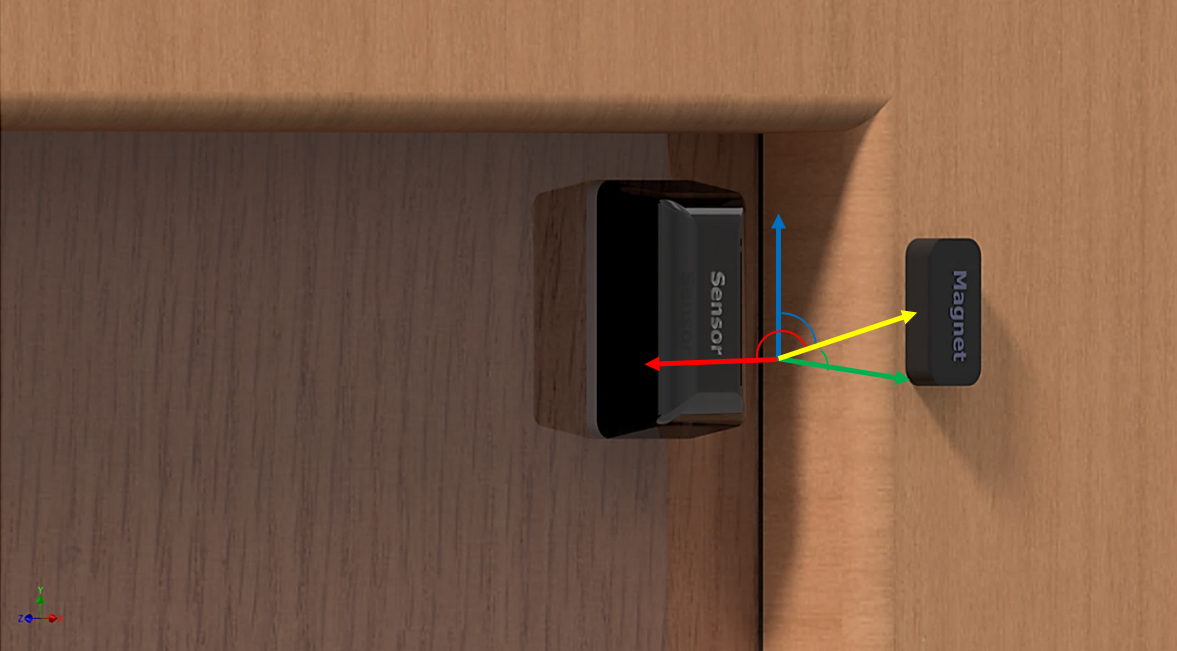SLYA086A February 2024 – September 2024 TMAG3001 , TMAG5233
Introduction
As the rate of security systems have been steadily increasing, so has the need for innovations for door and window contact sensors. Door and window sensors are often used in home security on each door and window throughout a household as a foundation to any home security system. Contact sensors are an essential part of security systems as the sensors alert a system to the opening or closing of each monitored entry point. Historically, reed switches were the design used in contact sensors due to simplicity; however, reed switches provide erratic detection fields which leaves the system vulnerable to tampering unlike Hall-effect sensors.
If a door or window is opened while the alarm system is active, the main alarm can be immediately triggered when the Hall-effect sensor sends an alert to the main control panel. Contact sensors are mostly battery powered where the Hall-effect sensor alternates between active measure mode and low-power sleep mode to reduce the average current consumption. It is crucial to use the most power efficient sensing design possible as these systems are designed to be compact and remain powered on continuously checking for entry and exit alerts.
Operation of Door and Window Sensors
Traditional door and window contact sensors are used to alert when someone enters or leaves a building or when an entry point is left open. Sensors are an essential part of security systems, making sure for peace of mind. The terms door and window sensors are interchangeable as each are classified as contact sensors. Typically, one dimensional magnetic switches are used to recognize the alterations in magnetic field when a door or window is opened or closed; however, one concern with this implementation is that these sensors only indicate one of two states. The sensed 1D magnetic flux density is either above or below the trip points of the device. As a result, it is possible to tamper with the system to think that the door or window is closed by using a strong enough external magnet to cause the trip point of the switch to be triggered despite the fact that the door or window can be opened.
Also, linear 3D Hall-effect sensors can be used to sense the exact magnetic flux density in all three directions, which allows the system to differentiate the magnetic signature of a door or window actually being closed from a tamper magnet being used in an attempt to fool the security system. 3D Hall-effect sensors can be used for open and close detection in space-constrained applications that require variations in mounting such as the position shown in Figure 1. The mounting position shown in Figure 1 has the door frame raised from the door which creates a change in distance in both the x and y axes.

 Figure 1 Typical Door Mounted Sensor with Raised Frame
Figure 1 Typical Door Mounted Sensor with Raised FrameHall-Effect Innovations in Door and Window Applications
The TMAG5233 is one of Texas Instruments' single-axis Hall-effect switches that offers in-plane magnetic sensing. Unlike most traditional Hall-effect switches, the TMAG5233 measures the magnetic field parallel to the package (vertical sensor) rather than through the Z-axis of the device package (horizontal sensor). With different variants available, users can decide which magnetic sampling frequency is best designed to meet the sampling and power requirements of the system.
The TMAG3001 is one of Texas Instruments' three-axis linear Hall-effect sensors with a dedicated interrupt (INT) pin that acts as a system interrupt during low-power wake-up and sleep mode. This device also features a configurable low-power switch mode for magnetic or angle measurements. The TMAG3001 can be used in contact sensors for open and close detection as well as tamper detection. The ultra-small WCSP package offers flexible mechanical placement in space-constrained applications like contact sensors.
Additionally, linear 3D Hall-effect sensors can be used in resistance to tampering. The TMAG3001 features advanced field detection capabilities and can detect magnetic fields in the x, y, and z planes, allowing the system to detect when a sensor is being tampered with. Once the device detects tampering, the system can alert the user. Figure 2 shows a testing setup of a Hall-effect sensor mounted on a sliding glass entry door. In this test, a magnet is brought close to the door from the opposite side until the LED goes off, indicating the sensor has detected a change in the magnetic field due the tamper magnet. As Figure 2 shows, the tamper magnet in this test was able to trip the Hall-effect sensor through the door.
 Figure 2 Tamper Test Setup
Figure 2 Tamper Test SetupWake-up and Sleep Mode
To optimize power consumption, the TMAG3001 features a wake-up and sleep mode in which the device can be configured to go to sleep and wake up at a specific interval to measure the x, y, z directions, or temperature data. The device asserts an interrupt signal once the magnetic threshold cross is detected and exits wake-up and sleep mode and goes to the wait state for a period of time. In the wait state, the last measured data is stored in the corresponding result registers. The wake and sleep time period can be configured using predefined intervals. If the microcontroller does not respond to the interrupt in the wait state, then the device continues to be in wake-up and sleep mode. If the interrupt condition is not met, the device continues to be in the wake-up and sleep mode to wake up and measure data at the specified interval. Figure 3 below shows an example where the controller responds to the interrupt during the wait state and places the device back in wake up and sleep mode. The wake-up and sleep mode conserves energy during idle periods thus making the TMAG3001 an excellent choice for low-power applications such as contact sensors.
 Figure 3 TMAG3001 Interrupt Through SCL
Figure 3 TMAG3001 Interrupt Through SCLSignificance of Wake on Change
Similarly, a vital feature that the TMAG3001 offers is wake on change, which in this mode, the device monitors either one of the magnetic axes or the angle output for a change and wakes the system by providing an interrupt. To save power for battery applications, such as contact sensors, the TMAG3001 remains in wake on change mode until an interrupt is detected. This device can be configured to provide a wake on change response in standby, continuous or wake and sleep mode, when an interrupt response is obtained. The new sensor measurement is used as the reference threshold for the successive measurement. Figure 4 shows the device response where the device is responsive to the x-axis magnetic field and Figure 5 shows the device response where the device is responsive to the angle measurements. Traditionally, door and window sensors continuously consume power to monitor change, but the TMAG3001 eliminates the potential energy inefficiencies that this can present by enabling relative magnetic limit checks for both magnetic field and angle measurements.
 Figure 4 TMAG3001 Wake on Change with Magnetic Axes Measurements
Figure 4 TMAG3001 Wake on Change with Magnetic Axes Measurements Figure 5 TMAG3001 Wake on Change with Angle Measurements
Figure 5 TMAG3001 Wake on Change with Angle MeasurementsConclusion
Door and window contact sensors are becoming more common in consumer and industrial security systems due to the added convenience and energy conservation abilities. Many factors need to be accounted for to offer the most robust design while also offering tamper detection. Low-power linear 3D Hall-effect sensors such as the TMAG3001, TMAG5170, and TMAG5273 provide designers with added mechanical flexibility for space-constrained applications and advanced field detection capabilities. The incorporation of the wake-on-change feature in Hall-effect sensors proves to be highly beneficial; especially when used for security purposes. By allowing sensors to remain in a low-power state until a significant magnetic field change is detected, the energy efficiency is optimized extending battery life. The implementation of the wake on change feature can make Hall-effect sensors a key component in security systems across various diverse industries.
| Device | Characteristics | Design Considerations |
|---|---|---|
| TMAG3001 | Low-power 3D linear and angle Hall-effect sensor with I2C interface and wake up detection in YBG package. | Measures magnetic field strength on X,Y, and Z axes and reports data over I2C interface. Great for low-power applications. This device can operate on as little as 1.65V. Configurable power mode options allow for system performance and current consumption optimization. |
| TMAG5273 | Low-power linear 3D Hall-effect position sensor with I2C interface available in 6-pin SOT-23 package. | Measures magnetic field strength on all 3 axes and reports data over I2C interface. This device can operate on as little as 1.7V. Configurable power mode options allow for system performance and current consumption optimization. |
| TMAG5170 | High-precision linear 3D Hall-effect position sensor with SPI available in 8-pin DGK package. | Measures magnetic field strength on all 3 axes and reports data over SPI. This device offers high precision and self-diagnostic features beneficial for system monitoring. |
| TMAG5233 | In-plane digital Hall-effect switch with omnipolar magnetic response. Available in an industry-standard SOT-23 package. | Measures magnetic field parallel to the package rather than through the Z-axis of the device. Available in 5Hz or 40Hz magnetic sampling frequencies. |
| DRV5032 | Ultra-low-power digital switch Hall-effect sensor available in SOT-23, X2SON, and TO-92 packages. Both omnipolar and unipolar options available. | Great for low-power applications. This device can operate on as little as 1.65V with typical current consumption below 1μA. DU and FD variants in X2SON have dual unipolar functionality. |
| Name | Description |
|---|---|
| Measuring 3D Motion With Absolute Position Sensors | A discussion on the differences between a linear output and switched output Hall-effect sensors. |
| Angle Measurement With Multi-Axis Hall-Effect Sensors | A guide to monitoring absolute angle position using a 3D Hall-effect sensor |
| TMAG3001EVM | GUI and attachments incorporate angle measurement using a precise three dimensional linear Hall-effect sensor |
| TMAG5170UEVM | GUI and attachments incorporate angle measurement using both precise three dimensional linear Hall-effect sensors integrated in this one device |
| TMAG5273EVM | GUI and attachments incorporate angle measurement using a three dimensional linear Hall-effect sensor |
| TI Precision Labs - Magnetic Sensors | A helpful video series describing the Hall effect and how to use the Hall effect in various applications. |
| 6 More Myths about Hall-effect Sensors | A Technical Article on common misconceptions on Hall-effect witches and latches, including common applications where designs can benefit from using Hall-effect sensors |
| Reed Switch Replacement with TI's Hall-effect and Linear 3D Hall-effect Sensors | An application note that delivers side-by-side performance comparisons of a Reed switch, the DRV5032, and the TMAG5170. |